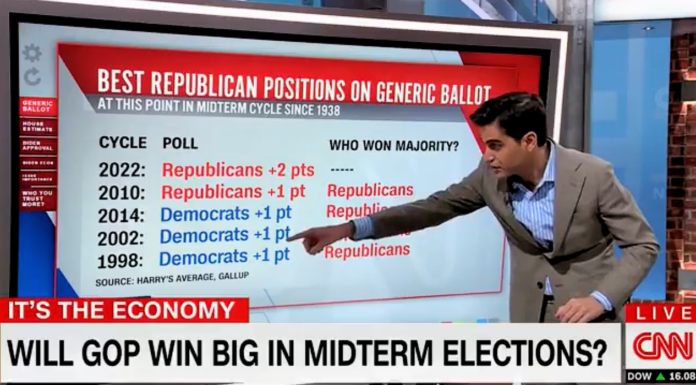(By Jon Miltimore, FEE) For more than a quarter-century, we’ve been hearing predictions about the demise of cable—and with it, cable news.
A Pew Research article from 2000 showed the trends began more than 30 years ago, when consumption of broadcast and local news began to decline, and users began to get more news (and entertainment) online.
These trends have only increased since, to the extent that the long decline in cable news may finally be reaching its end.
“This week might well mark the last time we ever care so much about cable TV news,” veteran media analyst Alan Wolk noted in April, following the surprising departures of Tucker Carlson from Fox News and Don Lemon from CNN.
Wolk wasn’t saying cable news was necessarily a terrible product; it was an obsolete one on an obsolete platform. While he didn’t predict that the death of cable was imminent, he made it clear it might be time to start looking for hospice care.
“…eventually, probably sometime in the next five to ten years, cable TV is going to stop being worth it for all parties involved and will, for all intents and purposes, disappear,” Wolk wrote.
End of Days?
The decline of cable is obviously bad news for the six largest cable news networks (Fox, CNN, Fox Business, MSNBC, CNBC, and HLN).
Paul Farhi of the Washington Post points out that fewer people watching cable news doesn’t just mean less ad revenue, which accounted for $2.6 billion in revenue collectively for the cable giants last year. It also means less revenue from cable providers, who provide cable news networks the majority of their revenue ($4 billion) through licensing fees.
“…the day could soon come when an exodus of cable subscribers leaves cable operators unable to afford the hefty license fees that those news programmers now command,” Farhi writes.
This is obviously bad news for cable news companies. Ditto for talking heads like Jake Tapper and Sean Hannity, both of whom pull in eight-figure salaries.
For consumers, content creators and society generally, however, the collapse of cable news is nothing to be feared.
Of Creative Destruction and ‘Obsolescent Industries’
In his classic work Capitalism, Socialism, and Democracy, Austrian political economist Joseph Schumpeter stated that by its very nature capitalism is an evolutionary process, one that is never stagnant or stationary. He explained that capitalism “incessantly revolutionizes the economic structure from within, incessantly destroying the old one.” Schumpeter saw there would be a natural impulse to “conserve obsolescent industries,” but he rightly understood this was generally a futile and self-defeating task.
“At the heart of capitalism is creative destruction,” Schumpeter wrote of the economic concept he coined.
Today’s cable news networks are victims of this process, “creative destruction.” They are the “obsolescent industries” of which Schumpeter speaks, and consumers are fleeing for greener pastures where they are served with better options.
Companies like Netflix are often credited with disrupting the movie industry, and they have. But this disruption goes well beyond Hollywood. Online streaming has disrupted the entire media landscape, and it’s not just Fortune 500 companies like Netflix, Apple, Google, and Amazon doing the disrupting. Spotify, Substack, Twitter, Rumble, and others have given content creators new platforms to reach hundreds of millions of people.
This media evolution is a great deal for consumers. Instead of dropping $200 a month for a ridiculous number of channels, viewers can purchase subscriptions as they see fit. Baseball fans can purchase a yearly MLB package for $150—less than a single month of the price of cable. Netflix can be bought for as little as $6.99 a month. Amazon customers get streaming thrown in for free with their Prime subscription. Fans of commentary can purchase HBO Max (now just Max) and get their political fix with Bill Maher in addition to the movies and original programming. If Maher isn’t enough, they can watch countless other commentators for free on YouTube or Rumble.
For consumers and content creators, we’re living in a new golden age of media. Consumers have virtually endless options, and each of us is able to select from the menu based on our individual tastes and pocketbooks. Content creators, meanwhile, get to pursue their entrepreneurial passion and get paid by bringing their message to audiences.
This of course doesn’t mean that there are no losers.
For Sean Hannity, who rakes in a reported $43 million a year, this democratization of media is probably distressing. Ditto for legacy media companies, who now have to compete with more content creators than ever. And then there is the government.
Nobody is likely to be more concerned over our brave new world of media freedom than the state, which historically has attempted to control and restrict the free flow of information to suit its own ends. This task was considerably easier prior to the democratization of media, when the nightly news consisted of Walter Cronkite reporting each evening.
To be fair, I think many of today’s cable news hosts could learn something from Cronkite, the “most trusted” man in America, who exuded professionalism and objectivity with his dispassionate style.
But make no mistake: More choices and voices is a healthy thing for a democratic society, and that’s exactly what the market has provided.

